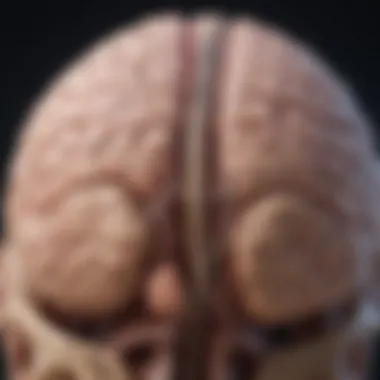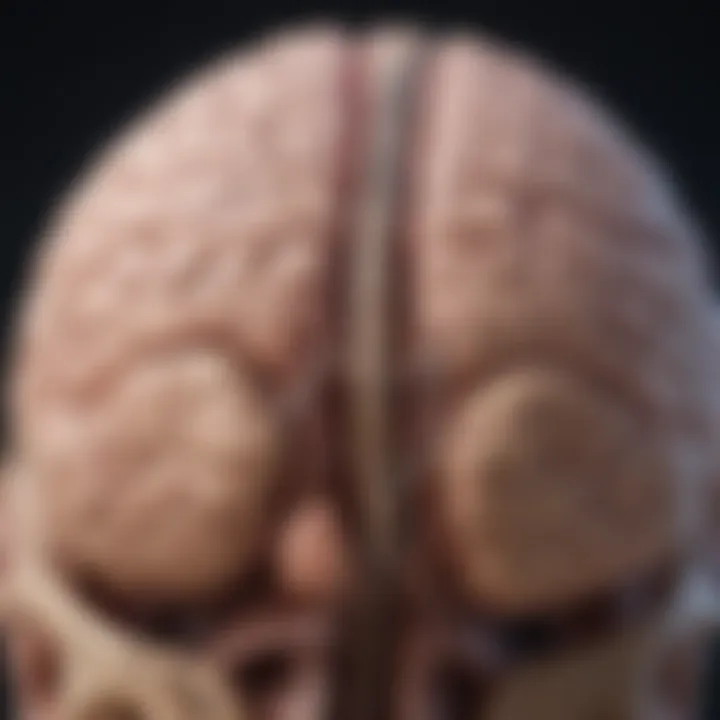The Prefrontal Cortex: Functions and Significance


Intro
The prefrontal cortex plays a pivotal role in various higher-order cognitive functions. This region is situated at the front of the brain and is distinct from other parts through its unique structure and organization. Its involvement in tasks such as reasoning, planning, and decision-making is crucial for effective functioning in daily life.
Its significance extends beyond mere cognition. The prefrontal cortex is also integral in emotional regulation. Emotional responses are often intertwined with cognitive processes, which indicates the importance of this brain area for mental health. A clear understanding of the prefrontal cortex helps decode its influence on behavior and its relationships with psychological disorders.
In this article, we will explore its anatomical structure, developmental evolution, and the interaction with other brain regions. We aim to uncover the correlational findings in contemporary research, which provide insights into understanding the consequences of dysfunction in this crucial area. Knowing these aspects gives rise to deeper awareness of its relevance in both healthy individuals and those with mental health challenges.
Research Highlights
Overview of Key Findings
Research highlights the various roles the prefrontal cortex plays in cognitive and emotional tasks. It has been identified as the center for:
- Executive functions such as planning and reasoning.
- Social behavior regulation, influencing interactions with others.
- Impulse control, essential for decision-making processes.
Studies utilizing neuroimaging techniques reveal distinct patterns of activity in the prefrontal cortex during complex tasks. These findings indicate how this brain region works alongside others to ensure coherence between thought processes and emotional responses.
Significance of the Research
Understanding the prefrontal cortex sheds light on mental health conditions. Dysfunction in this area has been linked to disorders such as depression, anxiety, and schizophrenia. This relationship emphasizes the need for focused research to develop treatments that address these dysfunctions.
Moreover, this area is often the focus in neuropsychological assessments. Assessing prefrontal cortex functions can lead to better diagnosis and interventions for individuals facing cognitive challenges.
"By exploring the prefrontal cortex, we can illuminate pathways to improved mental health and cognitive function."
Original Research Articles
Summary of the Article
Recent original research has made significant contributions to understanding the prefrontal cortex. Articles published in established journals present findings from animal models and human studies. They often focus on the neural circuits within the prefrontal cortex and their influence on decision-making.
Author Contributions
In these discussions, lead researchers have made substantial impacts by integrating findings from various fields. They combine insights from neuroscience, psychology, and behavioral studies to provide a comprehensive view. The multidisciplinary approach has promoted deeper understanding and collaboration throughout the scientific community.
By examining ongoing research and clinical observations, we gain insights essential for future studies aimed at harnessing the full potential of prefrontal cortex research in psychological health.
Prelims to the Prefrontal Cortex
The prefrontal cortex is an essential part of the human brain, overseeing a wide range of cognitive functions, emotional regulation, and complex decision-making. Its significance extends beyond basic brain activity; it is central to what makes us human. Understanding this region is paramount, as its integrity can directly influence behavior and personal development. This introduction will establish the importance of exploring the prefrontal cortex in detail, including its anatomical structure, historical context, and functional significance.
One crucial aspect to consider is its involvement in executive functions, such as planning, reasoning, and impulse control. These functions allow individuals to process information effectively and adapt their behaviors according to different situations. Given that many psychological disorders are linked to dysfunction in this area, the prefrontal cortex is of particular interest to both researchers and clinicians.
"The prefrontal cortex serves as the brain's command center. It coordinates actions, thoughts, and emotions, thus influencing daily functioning."
Engaging in an examination of the prefrontal cortex not only provides insights into brain health but also stresses the value of emotional intelligence in various contexts. Cultivating an understanding of this region can pave the way for improved therapeutic strategies and educational approaches. Therefore, this article aims to analyze the prefrontal cortex's anatomy, its development over time, and its vital functional roles in everyday life, particularly in relation to decision-making and emotional regulation.
Defining the Prefrontal Cortex
The prefrontal cortex is located at the front of the frontal lobe, making up a significant portion of the brain's overall structure. It is most recognizable for its role in higher-order thinking. This region is often described as the heart of our personality, controlling our ability to plan, focus attention, and juggle multiple tasks simultaneously. Its intricate neural pathways link it with various other regions in the brain, facilitating an integrated approach to cognitive processing.
The prefrontal cortex can be divided into several areas: the dorsolateral prefrontal cortex, which is involved in executive functions and working memory; the ventromedial prefrontal cortex, linked to emotional regulation and social behavior; and the orbitofrontal cortex, responsible for reward processing and decision-making. Each area contributes distinctly to overall brain function.
Historical Perspectives
Understanding the prefrontal cortex's development through history reveals much about its complex functions. Research has evolved dramatically over the years, shifting from largely theoretical discussions to empirical studies involving modern imaging techniques. Early views considered this part of the brain as primarily a control center for motor functions, but eventual studies illuminated its far broader role.
Notably, in the mid-20th century, psychologist and neuroscientist B. F. Skinner conducted experiments that established connections between behavior and the brain. Later, pioneering work during the 1990s by researchers such as Antonio Damasio emphasized the prefrontal cortex's significance in integrating emotions with cognition. Today, this understanding continues to expand, as scholars explore how it interacts with other cognitive mechanisms. In this ongoing journey to unveil the enigma of the human mind, the prefrontal cortex remains central to understanding behaviors that define the human experience.
Anatomy of the Prefrontal Cortex
The anatomy of the prefrontal cortex is crucial to understanding its wide range of functions. This region of the brain is located at the front of the frontal lobes and is distinguished by its unique structural components. Diving into its anatomy reveals how interconnected and complex this part of the brain truly is. These anatomical features play a significant role in how the prefrontal cortex interacts with other regions and how it influences various cognitive and emotional processes.
Structural Components


The prefrontal cortex is made up of several distinct areas. These areas include the dorsolateral prefrontal cortex, the ventromedial prefrontal cortex, and the orbitofrontal cortex. Each component has specialized roles.
- Dorsolateral prefrontal cortex: This area is primarily involved in executive functions, such as planning, decision-making, and working memory.
- Ventromedial prefrontal cortex: This part plays a key role in emotional regulation and social decision-making.
- Orbitofrontal cortex: It is essential for reward processing and the evaluation of emotional stimuli.
The architecture of the neurons in these areas also varies. For instance, pyramidal neurons are prominent in the prefrontal cortex and are involved in sending signals to various brain regions. The density and connections of these neurons can be altered by experiences and learning, emphasizing the plasticity of the prefrontal cortex.
Connections with Other Brain Regions
The prefrontal cortex does not function in isolation. It has extensive connections to many areas of the brain. Understanding these connections is vital for grasping how the prefrontal cortex performs its roles.
- It links with the limbic system, influencing how emotions affect cognition and behavior.
- Connections to the parietal lobes allow for integrating sensory information, critical for contextual decision-making.
Additionally, it communicates with the basal ganglia, which helps in managing habitual actions and motor planning. The extensive network of connections enables the prefrontal cortex to perform higher-order processing efficiently.
"The prefrontal cortex serves as the brain's command center, integrating functions from diverse areas to support complex behaviors and cognitive tasks."
In summary, understanding the anatomy of the prefrontal cortex provides deep insight into its functional relevance. Its structural components contribute to the complex interplay of cognitive and emotional processes, while its connections with other brain regions highlight the integration essential for effective functioning.
Development of the Prefrontal Cortex
Understanding the development of the prefrontal cortex is essential to comprehend its complex functionalities. This region matures over an extended period, far longer than many other brain areas. Its development influences cognitive processes, social behavior, and emotional regulation, ultimately impacting an individual's ability to navigate their environment. Exploring this development allows researchers and professionals to grasp the significance of neural growth and adaptation during critical periods of life.
Stages of Development
The development of the prefrontal cortex occurs through defined stages, each characterized by specific growth patterns and milestones.
- Prenatal Stage: The foundation begins during pregnancy. Early neural differentiation occurs, with precursor cells forming the basic architecture of the prefrontal cortex.
- Infancy: After birth, the prefrontal cortex continues to develop rapidly. Synaptogenesis, the formation of synapses, peaks around the first two years of life, which shapes essential functions like attention and impulse control.
- Childhood and Adolescence: During childhood, the prefrontal cortex undergoes significant change. Myelination increases, enhancing the speed of neural communication. By adolescence, there is a pruning phase where excess synapses are eliminated. This process is crucial for refining cognitive functions and behaviors to fit more complex societal demands.
- Early Adulthood: The prefrontal cortex continues maturing into the mid-20s. It achieves a state that supports advanced cognitive abilities such as strategic planning, problem-solving, and emotional regulation. This late maturation underscores why emotional and impulsive behavior may be more pronounced in younger individuals.
Each of these stages plays an integral role in developing a well-functioning prefrontal cortex, aligning cognitive abilities with behavioral expectations in social contexts.
Impact of Environmental Factors
Environmental factors significantly influence the development of the prefrontal cortex. These can either enhance or inhibit its growth and functionality. Several critical elements include:
- Nutrition: Proper nutrition is vital for brain development during early life. Deficiencies can lead to long-term cognitive impairments.
- Social Interaction: Positive social experiences contribute to healthy emotional development. Conversely, neglect or adverse events can hinder growth, leading to emotional dysregulation later in life.
- Stress: Chronic stress can affect brain structures. High levels of stress hormones, like cortisol, can adversely impact the maturation of the prefrontal cortex, resulting in difficulties with memory and decision-making.
- Physical Activity: Engaging in physical activity has been shown to promote neurogenesis and synaptic plasticity in the prefrontal cortex. The connection between an active lifestyle and cognitive functions highlights the importance of fostering healthy habits early on.
In summary, environmental inputs during formative years are critical to shaping the prefrontal cortex's development. Understanding these factors provides insight into preventative measures and interventions that can optimize cognitive and emotional outcomes across the lifespan.
Functional Roles of the Prefrontal Cortex
The functional roles of the prefrontal cortex are pivotal in understanding its impact on human behavior and cognition. This region of the brain underpins various advanced processes that define our ability to interact with our environment intelligently. The prefrontal cortex is not just involved in simple tasks; it plays a significant role in integrating complex cognitive functions, managing emotions, and influencing decision-making. The exploration of its functionalities sheds light on how we adapt and respond to diverse situations in everyday life.
Cognitive Functions
Executive Functions
Executive functions represent a core aspect of cognitive processes managed by the prefrontal cortex. They encompass higher-order skills necessary for effective reasoning, problem-solving, and planning. One key characteristic of executive functions is their role in goal-directed behavior. These functions allow individuals to manage their thoughts, actions, and emotions in pursuit of objectives.
In this context, executive functions are crucial for not only personal success but also for collective societal well-being. They facilitate the ability to prioritize tasks, allocate resources efficiently, and inhibit impulsive responses. A unique feature of executive functions is their adaptability. For example, they can evolve with experience and education, becoming more refined over time. Despite their advantages, challenges such as anxiety or ADHD can hinder the effectiveness of executive functions, leading to difficulties in daily life.
Working Memory
The concept of working memory is closely linked with cognitive functions in the prefrontal cortex. It refers to the capacity to hold and manipulate information over short periods. Working memory plays a significant role in reasoning and comprehension tasks. A key characteristic is its limited capacity; typically, one can only manage about seven pieces of information at once. This makes working memory essential for tasks that require active thinking and analysis.
In this article, working memory is highlighted as beneficial because it supports learning and decision-making. Its unique contribution lies in allowing individuals to process information in real-time, enabling adjustments and refinements during task execution. However, working memory can be fragile under stress or fatigue, which can impair overall cognitive performance.
Emotional Regulation
Emotional regulation is another critical functional role attributed to the prefrontal cortex. This region actively modulates emotional responses, ensuring that feelings align with appropriate behavioral responses. Through the filtering and processing of emotional stimuli, the prefrontal cortex aids in maintaining a balanced emotional state, which is vital for decision-making and social interactions. Additionally, deficits in emotional regulation can give rise to various psychological conditions, illustrating the importance of the prefrontal cortex in overall mental health.
Decision-Making Processes
The prefrontal cortex is integral in decision-making processes. It enables individuals to evaluate options and consequences before acting. Its link to rational thinking allows for calculated choices rather than impulsive reactions. Decision-making often requires weighing benefits against risks, often within uncertain contexts. The capabilities of the prefrontal cortex help navigate these complex scenarios, leading to more favorable outcomes.
"The prefrontal cortex's role in decision-making cannot be overstated; it is the epicenter of our ability to foresee long-term consequences and make judicious choices."
Neuroimaging Studies of the Prefrontal Cortex


Neuroimaging studies play a significant role in understanding the prefrontal cortex. They enable researchers to observe the brain in action, providing a window into how this complex region functions under various conditions. Using different neuroimaging techniques, scientists can discern patterns of activity associated with cognitive tasks, emotional responses, and decision-making processes. These insights are crucial for both basic science and clinical applications, enhancing our understanding of normal brain function and identifying deviations linked to psychological disorders.
Functional MRI Insights
Functional magnetic resonance imaging (fMRI) has revolutionized the way researchers study brain activity, particularly in the prefrontal cortex. This technique measures brain activity by detecting changes in blood flow, which correlates with neuronal activity. The prefrontal cortex is highly dynamic, with its regions activated during different tasks. For instance, studies show increased blood flow in this area during complex decision-making and problem-solving tasks.
Notable findings from fMRI studies indicate that specific areas of the prefrontal cortex, such as the dorsolateral prefrontal cortex, are essential for executive functions. These include planning, working memory, and cognitive flexibility. A study using fMRI highlighted how individuals with stronger activation in these areas performed better on tests measuring cognitive flexibility. Such insights underscore the relationship between brain activity and cognitive performance.
Electrophysiological Findings
Electrophysiological techniques, such as electroencephalography (EEG) and single-unit recordings, facilitate a different aspect of research into the prefrontal cortex. These methods capture the electrical activity of neurons, offering high temporal resolution that complements fMRI's spatial insights.
Research utilizing EEG has shown that the prefrontal cortex plays a crucial role in regulating attention and emotion. Specific patterns of brain waves, particularly during tasks requiring sustained attention, indicate the involvement of the prefrontal regions. Furthermore, studies involving single-unit recordings in animal models have identified how individual neurons in the prefrontal cortex respond to various stimuli, contributing to our understanding of their role in cognitive functions.
The Prefrontal Cortex in Health
The prefrontal cortex plays an essential role in maintaining the various aspects of health and functioning within daily life. This part of the brain is often involved in higher-order processes such as decision-making, emotional regulation, and social interactions. Understanding the functions of the prefrontal cortex in the context of health can provide insights into how it contributes to overall well-being and how disruptions in its activity can influence behavior and cognition.
Normal Functioning in Daily Life
The normal functioning of the prefrontal cortex is crucial for effective navigation through everyday tasks. This brain region helps in planning and prioritizing actions based on prior experiences. Individuals engage in complex social dynamics, whether at work or home. For example, the ability to interpret facial expressions, assess social cues, and respond appropriately relies significantly on the prefrontal cortex. Its involvement ensures that responses are aligned with long-term goals.
Factors such as consistent sleep patterns, balanced nutrition, and regular physical activity contribute to the health of the prefrontal cortex. Each element plays a crucial role in maintaining optimal cognitive performance and emotional stability. A well-functioning prefrontal cortex enhances our ability to adapt to changing situations and make informed decisions based on available information.
The Role in Learning and Adaptation
The prefrontal cortex also serves a vital role in learning and adaptation. This region is involved in cognitive flexibility, enabling the brain to adjust to new information and modifying behavior based on ongoing feedback. For instance, when students learn new concepts, the prefrontal cortex is engaged in assessing how prior knowledge fits with new material.
Through mechanisms such as working memory, it helps hold relevant information temporarily as one processes it. This function is essential for problem-solving and creativity. Without a properly functioning prefrontal cortex, individuals may struggle to adapt to new learning environments or learn from mistakes.
In summary, the prefrontal cortex significantly impacts health and functioning in daily life through its roles in social interaction, decision-making, and adaptability. It is intertwined with both mental and emotional health, indicating that fostering good health practices can lead to better function of this critical brain area.
"A well-functioning prefrontal cortex is linked to enhanced cognitive performance, emotional regulation, and adaptability."
Understanding these elements helps draw a clearer picture of the prefrontal cortex's significance in maintaining a balanced and healthy life.
Dysfunction of the Prefrontal Cortex
Dysfunction of the prefrontal cortex is a significant theme in understanding both psychological disorders and cognitive behaviors. This section aims to elucidate how impairments in this critical region influence various mental health issues. Focusing on the repercussions of dysfunction gives insights into the importance of this area for emotional control, decision-making, and overall well-being.
Associated Psychological Disorders
Depression
Depression is a common psychological disorder linked closely to prefrontal cortex dysfunction. The particular aspect of interest here is the decreased activity in the prefrontal cortex observed in individuals suffering from depression. This can contribute to impaired decision-making and diminished emotional regulation, both hallmark features of depression.
The key characteristic of depression is its pervasive sadness and loss of interest in activities that were once enjoyable. This disorder is a beneficial choice for exploration because it reflects how dysfunction in cognitive control areas of the brain can lead to significant behavioral changes.
A unique feature of depression is its episodic nature. While some individuals may experience prolonged depressive symptoms, others encounter episodes interspersed with periods of relative normalcy. This varying expression highlights both the complexities of depression and the challenges it presents for treatment and understanding.
Anxiety Disorders
Anxiety disorders also showcase significant implications of prefrontal cortex dysfunction. It is important to discuss the hyperactivity in some areas of this region seen in individuals with anxiety disorders. Such overactivity relates to excessive worry and impaired risk assessment.
The central element of anxiety disorders is their persistent feelings of fear and apprehension. This makes them a relevant theme for our analysis, as they illustrate how disrupted cognitive processes can lead to maladaptive responses. The unique characteristic here is how anxiety manifests both cognitively and physically, impacting daily functions.
One advantage of studying anxiety disorders in relation to prefrontal dysfunction is the potential for targeted interventions. Cognitive Behavioral Therapy, for instance, is designed to recalibrate the dysfunctional thought patterns by using techniques that may strengthen prefrontal activity.
Schizophrenia
Schizophrenia offers another lens to explore prefrontal cortex dysfunction. A specific aspect worth noting is the disorganized thinking and impaired executive functioning common in this disorder. These disturbances can often trace their roots back to alterations in prefrontal cortex connectivity.
The key characteristic of schizophrenia is the presence of psychotic symptoms, such as hallucinations and delusions. Its inclusion in this article is beneficial because it emphasizes severe impairments in both cognition and emotional processing.
A unique feature of schizophrenia is the broad spectrum of symptoms, which can vary greatly between individuals. This variability challenges not only clinical practice but also lends complexity to understanding the neurobiological underpinnings. The advantage of discussing schizophrenia lies in its deep implications for understanding the spectrum of cognitive abilities and the role the prefrontal cortex plays in maintaining mental stability.


Implications for Behavior and Cognition
The implications of dysfunction in the prefrontal cortex extend beyond individual disorders. These deficits can lead to sweeping changes in behavior and cognition. Individuals may exhibit impulsive actions, difficulty with planning, and challenges in managing emotions.
Understanding these implications is crucial. Acknowledge that interventions targeting the prefrontal cortex can yield tangible benefits in clinical settings. By exploring these relationships, we can begin to appreciate the diverse challenges posed by psychological disorders tied to this region.
Therapeutic Approaches Targeting the Prefrontal Cortex
The exploration of therapeutic approaches targeting the prefrontal cortex is essential in understanding how we can enhance mental health and cognitive functioning. Given the prefrontal cortex's critical role in decision-making, emotional regulation, and various cognitive tasks, effective therapies can provide significant benefits. These approaches shine a light on innovative methods that aim to alleviate psychological disorders linked to this brain region. In recent years, researchers and practitioners have focused on both psychotherapeutic interventions and neurostimulation techniques to tap into the potential of the prefrontal cortex.
Psychotherapeutic Interventions
Psychotherapeutic interventions are key strategies in targeting the prefrontal cortex for treating various mental health conditions. Cognitive Behavioral Therapy (CBT) is one approach that focuses on addressing cognitive distortions and negative thought patterns. By helping individuals restructure their thoughts, CBT can lead to improvements in emotional regulation and decision-making processes. Furthermore, this therapy encourages the engagement of the prefrontal cortex, which can lead to strengthened neural pathways that manage executive functions.
Another intervention is mindfulness-based therapy. This approach fosters increased awareness of one's thoughts and emotions, enabling individuals to respond rather than react impulsively. Mindfulness exercises have shown to enhance the connectivity between the prefrontal cortex and other regions involved in emotional regulation. More studies are highlighting how sustained mindfulness practice can lead to structural changes in the brain, particularly in the prefrontal cortex.
Other psychotherapeutic strategies, such as Dialectical Behavior Therapy (DBT), also target the prefrontal cortex. DBT combines cognitive-behavioral techniques with mindfulness to improve emotional regulation. This therapy is especially effective for individuals with personality disorders, equipping them with skills to navigate intense emotions and challenging situations.
"Psychotherapeutic interventions are not just treatments; they are pathways to understanding the self at a deeper level."
Neurostimulation Techniques
Neurostimulation techniques offer an alternative approach in targeting the prefrontal cortex. These methods utilize electrical or magnetic stimulation to enhance cognitive functions and treat mental health disorders. One prominent technique is Transcranial Magnetic Stimulation (TMS). TMS involves delivering magnetic pulses to the prefrontal cortex, which may help alleviate symptoms of depression and anxiety. Research suggests that regular application of TMS can lead to long-term changes in brain activity, promoting healthier functioning in the prefrontal regions.
Another notable technique is Deep Brain Stimulation (DBS). DBS is a more invasive procedure that involves the implantation of electrodes in specific brain regions, including areas connected to the prefrontal cortex. It is currently being explored for treatment-resistant depression and obsessive-compulsive disorder. Clinical trials show that DBS can result in notable improvements in emotional regulation and decision-making, but it requires careful consideration regarding candidate selection and risks involved.
In addition to these techniques, researchers are investigating the potential of using non-invasive brain stimulation methods, such as transcranial direct current stimulation (tDCS). This approach modulates neuronal activity in targeted areas of the brain. Studies indicate that tDCS can potentially enhance cognitive abilities, including working memory and impulse control, both of which are functions attributed to the prefrontal cortex.
The advances in psychotherapeutic and neurostimulation techniques illustrate a growing understanding of the prefrontal cortex’s role in mental health. These therapeutic approaches not only aim to treat symptoms but also foster better cognitive and emotional functioning.
Understanding these methods can pave the way for more effective interventions, ultimately enhancing the quality of life for individuals affected by psychological disorders.
Future Directions in Prefrontal Cortex Research
Research into the prefrontal cortex is evolving rapidly, revealing new insights into its functions. Understanding future directions in this field is crucial for several reasons. First, it highlights the need for ongoing exploration of the prefrontal cortex, which plays a pivotal role in cognition and emotional processing. Investigating this region can lead to improved therapeutic strategies for psychological disorders associated with its dysfunction.
The field of neuroscience is continuously changing, especially with developed technologies. Future research may uncover deeper connections between the prefrontal cortex and other regions of the brain. This understanding can refine approaches in numerous disciplines, including psychology, psychiatry, and neurobiology.
Technological Advances in Study Methods
Technological advancements are at the forefront of prefrontal cortex research. Techniques like functional MRI (fMRI) and transcranial magnetic stimulation (TMS) allow researchers to investigate brain function in real time. These methods bring precision to studying brain networks. Researchers can analyze how various factors influence the prefrontal cortex.
Additionally, advancements in imaging technologies help visualize brain activity and structure on an unprecedented scale. This allows for better identification of structural abnormalities in the prefrontal cortex linked to conditions like schizophrenia and depression.
New data-analysis techniques are also emerging, including machine learning algorithms. They can discover patterns in large datasets, providing insights previously missed.
Current exploration aims at not only understanding dysfunction but also revealing the normal variations of prefrontal cortex connectivity, which informs basic neuroscience.
Potential for New Therapeutic Developments
Future research may yield novel therapeutic interventions targeting the prefrontal cortex. As understanding of how this brain region interacts with psychological disorders deepens, new treatments can emerge. This is paramount, especially for conditions like anxiety disorders or attention deficit hyperactivity disorder (ADHD).
Pharmacological therapies could be tailored to enhance or modulate the activities of neurotransmitters in the prefrontal cortex. In particular, treatments could focus on the dopamine and serotonin systems, which are crucial in mood and cognition.
Furthermore, the application of non-invasive stimulation techniques like neurofeedback or TMS may become standard procedures to regulate brain activity. These therapies could offer personalized approaches to managing symptoms affecting individuals with prefrontal cortex-related disorders.
The ongoing exploration will not only enhance treatment modalities but may also reshape our understanding of mental health altogether. As technology and research methods improve, the promise for more effective therapeutic outcomes grows stronger.
Closure
Understanding the intricacies of the prefrontal cortex is vital for grasping its role in both cognitive and emotional domains. This article has outlined how this brain region influences our decision-making, emotional regulation, and overall behavior. The discussion highlighted the prefrontal cortex's structural characteristics and its connections to other critical areas, emphasizing its significance in maintaining normal functioning in daily life.
Summary of Findings
A comprehensive examination of the prefrontal cortex reveals several important insights. First, it plays a crucial role in cognitive functions like executive functioning and working memory. It is essential for planning, reasoning, and problem-solving. Second, it is instrumental in regulating emotions, affecting how we respond to stress and challenges. Finally, it is integral to decision-making processes, impacting choices ranging from trivial to life-altering. In addition, dysfunction within the prefrontal cortex can lead to various psychological conditions, including depression and anxiety disorders. Understanding these findings provides a framework for future studies, particularly in areas concerning mental health.
Implications for Future Research
The relevance of prefrontal cortex research cannot be overstated. With ongoing advances in neuroimaging and electrophysiological methods, future studies could further unravel the complexities of this brain region. Researchers should explore the nuanced interactions between the prefrontal cortex and other brain structures. There is also an opportunity to investigate new therapeutic interventions targeting this region, which can lead to improved treatment strategies for psychological disorders. As we continue to unravel the intricacies of the prefrontal cortex, the potential for new discoveries and insights into human behavior remains vast.
"The prefrontal cortex is not just a region of the brain; it is foundational to who we are as individuals and how we navigate the world."
As our understanding deepens, so too will the possibilities for enhancing mental health and cognitive function, creating pathways toward a better quality of life.







